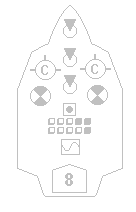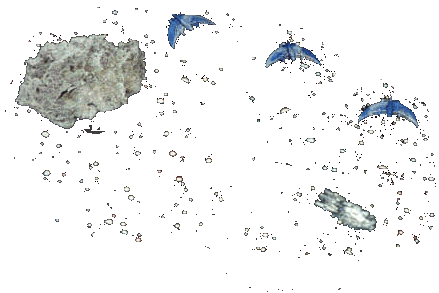

'Schild en Vriend' is an old Flemish battlecry, used in the rebellion of the city of Brugge against the French, May 18, 1302. Legend tells that it was used to differentiate between the French-speaking (who could not pronounce 'schild') and Flemish-speaking citizens. Nowadays, historians tell us that it was probably 'Des Gilden Vriend'.

The Human - Xirin wars
|
| The following is a copy of a human intel document regarding the development of the Xirin raider destroyers (DDK's). It was made up during the first days of the war when the new Ice Falcons were encountered as part of the advance recce/exploitation units of the Xirin attack fleets. The recovery of an Ice Falcon wreck after the battle of New Vilnius was an important element contributing to this document. |
--- Section 1: intel assesment
As a result of the search for new doctrines to partially counter the familiarity Human forces have with existing Xirin naval doctrine (due to the relatively long time of peaceful contact between the races before the war), Xirin Fleet General Staff introduced the idea of very fast, relatively heavy-hitting strike forces, capable of exploiting enemy confusion after the achievement of strategical surprise and the unhinging of enemy frontline forces. The strategic roles envisioned for these groups was as raiding forces operating well in enemy territory against small enemy fleet units in a fluid strategical situation. To this end, the raiding fleet units were to be i) fast, ii) capable of successfully engaging and significantly damaging multiple enemy targets of no bigger than cruiser size, iii) self-sustaining up to a certain degree and iv) consisting of either existing ships or be converted at relatively low cost from existing ships. These requirements inevitably led to the development of the raiding hunter/killer destroyer class, DDK, raider for short. The typical compositon of the raiding groups also follows from these requirements.
 The requirement for speed and maneuvrability necessitated hulls of escort class size, at least for the main component of the raiding groups, as providing any bigger ships with the required swiftness would violate the cost requirement (basically, would be too bloody expensive). Initially, attention went to swarms of small, frigate or smaller sized one-shot-only ships (the equivalent of two men with a hand-held launcher in a zodiac in the Persian Gulf in the late 20th century on Earth), but is was realized that the amount of supporting supply necessary to maintain a sufficient number of these ships would violate the self-sustenance requirement, necessitating a too big a portion of the raiding forces to be dedicated to supply ships. Thus, it was decided to employ destroyer-size hulls for the new raider class.
The requirement for speed and maneuvrability necessitated hulls of escort class size, at least for the main component of the raiding groups, as providing any bigger ships with the required swiftness would violate the cost requirement (basically, would be too bloody expensive). Initially, attention went to swarms of small, frigate or smaller sized one-shot-only ships (the equivalent of two men with a hand-held launcher in a zodiac in the Persian Gulf in the late 20th century on Earth), but is was realized that the amount of supporting supply necessary to maintain a sufficient number of these ships would violate the self-sustenance requirement, necessitating a too big a portion of the raiding forces to be dedicated to supply ships. Thus, it was decided to employ destroyer-size hulls for the new raider class.
Next came the problem of armament of the DDK class. The emerging doctrine for the raiding forces called for a heavy punch to be delivered in as short a time as possible. Employment of pulse torpedo type weapons was considered, but rejected because the small size of the destroyer hull only allowed one of these weapons to be carried, which does carry a considerable punch, but not in the short time called for in doctrine. Then, somebody dug up the plans for the Vampyre rocket pods, a weapon system the Xirin had tested some years ago, similar to our own Firestorm weapon system, but not adopted into actual fleet units. The Vampyres were simple packs of multiple fire-and-forget missiles carrying a light warhead and designed to be launched all at once at close range to an enemy ship. After some modifications to the original design, these weapons turned out to be the ideal weapon system for the new DDK class. As an added bonus, they could be very simply rigged to existing destroyer hulls, allowing them to be issued to the DDK's only days before the start of the war, thus decreasing the risk of prematurely warning the humans of the new weapon system. The weapon systems of the DDK's were rounded of with two C-class beam batteries for and two PDAF systems for local defence. After initial trials, several older Gull class destroyers were converted along these lines, giving birth to the new Ice Falcon class of raiders.
--- Section 2: Datavid - raider attack on Warthog CH near New Vilnius

Xirin Society
Although the relations between the humans and the Xirin have been quite good for a long period of time, little is known about the Xirin's Society structure and how the Xirin evolved.
If we look at how humanity evolved to a space empire, we see that the main factor that pushed our evolution ahead was war. If a species exists without any real danger it will do nothing to enhance its safety. On the other hand if an animal came to face a danger, it has to come up with ways to avoid or even counterattack this danger. Once this is done the necessity of further evolution becomes obsolete. But what happens when a species becomes his own worst enemy? The two parties make a continuous effort to outsmart each other and thus evolving to a higher technological society. However if two parties would wage war at each other for eternity, none of the found knowledge would be shared, slowing down the evolution considerably. A mix of war and peace and different enemies and allies is ideal to push a society into the economical era where economical warfare between companies takes over the role of warfare between countries.
What we do know about the Xirin is this. The Xirin are not one species as the humans. In fact there are three Xirin types: the Xiwon, the Inkašl and the Irini. These three groups are genetically as far apart as horses and donkeys, meaning that the children of a mixed couple can not bare children themselves (not that any Irini in his right mind would want have children with a Xiwon or Inkaal, and vice versa for that matter).
In this big diversity of the three groups lies the answer to the fact that although the Xirin are much older than the human race, they have obtained just an almost equal grade of technological know how.
Since the beginning of Xirin civilisation, the three groups have waged war against each other, but unlike humans they never shared their knowledge in times of peace. The gap between the races was simply too big. This resulted in a far slower evolution than the humans', as knowledge had to be obtained by espionage or theft.
This situation lasted until the three races evolved into the economical era when the big corporations saw the gigantic opportunity of trade between the different groups. To insure a fast progression of the company's know-how, they hired employees and researchers of all three races. Soon, the three groups acted as one society bearing the common name Xirin.
Politics followed with the assembly of the Xirin Commission and the Xirin Senate that, however symbolic in the beginning, continually increased its power over Xirin society. The highest and most powerful political organ however is the Triumvirate with its three consuls: Consul Ghet'Mih' for the Irini, Consul Havva Sygar for the Xiwon and Consul Fohn'doh'fju, of the Inkašl.
The Irini 'Ahnuld' Class Heavy Attack Cruisers
| Following intel document regards the development of the new Xirin/Irini CG. Intel was gathered by the Military bureau of intelligence. This type of ship was first seen in action during the battle of Yamato (also known as Tolstoy's peace) where it showed itself to be a devastating weapon. |
--- Section 1: intel assessment
The Irini have always been a special case within Xirin society. During the 'never ending' wars between the three groups the Irini had the lowest level of technological knowledge, but survived against the other two because the Irini consider the value of an individual life as being nihil, making them very fierce warriors who didn't hesitate to sacrifice their own lives in the general interest of the Irini population.
It is in this perspective that we have to regard the Ahnuld Class Heavy Cruisers. They are basically made of the hull of the old He-fusion power driven 6 Trust Hawk Class heavy Cruisers who were decommissioned from active service 30 years ago, keeping the production costs for this type of ship extremely low. This however is a bare necessity as the extremely weak hull makes them quite vulnerable to enemy fire. To compensate for this weak hull, they have a heavy weapon arsenal (3 extended range missile salvos, a class 3 battery and two submunition packs) capable of knocking serious holes into enemy defence lines. Their job is to get in, blow up everything in range and get out (although the last is quite often forgotten by the fierce Irini pilots).

Home | This page is maintained by Bart Vetters Schild en Vriend Miniature Wargaming Club Leuven |